December 1, 2017
Air Date: December 1, 2017
FULL SHOW
SEGMENTS

Congress More Bipartisan on Climate Change
View the page for this story
The bipartisan House Climate Solutions Caucus now has 62 members, with equal numbers of Democrats and Republicans. Caucus co-founder and Republican Florida Congressman Carlos Curbelo says it’s an effort to advance action on climate protection, even if President Trump and his Administration is standing in the way. Rep. Curbelo tells Host Steve Curwood that he believes the caucus is changing perspectives about global warming and is already has victories from pushing climate friendly measures and legislation on the Hill. (11:50)

The Tesla Truck
View the page for this story
Elon Musk’s pioneering electric car company Tesla has introduced its latest creation - an all-electric heavy-duty truck. The big rig’s sleek design and promises of cost-savings have persuaded retailers like Walmart to pre-order the truck for their fleets. USA Today Tech Reporter Marco Della Cava attended the unveiling event and offers host Steve Curwood his take on the truck’s place in the EV market, and the future of electric freight hauling. (08:26)
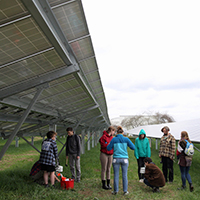
100% Sun Power for Hampshire College
View the page for this story
Hampshire College, with about 1400 students in Western Massachusetts, has just become the first residential U.S. College with 100% solar electricity. Hampshire College’s President, Jonathan Lash, joins host Steve Curwood to discuss the costs, benefits and ideas that underpin this switch to renewable energy. (06:51)
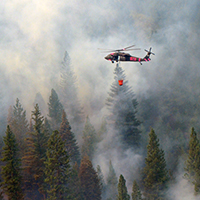
Beyond The Headlines
/ Peter DykstraView the page for this story
Peter Dykstra joins host Steve Curwood to consider the greenhouse gas emissions released by California’s intense wildfire season. The pair also discuss new research that proposes to extract useful chemicals from sewage and look back to 1980 – the year President Jimmy Carter signed the Alaska Land Bill and protected 80 million acres from energy development. (03:14)
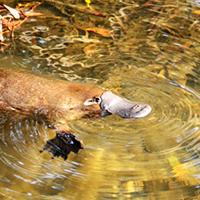
Improbable Destinies: Fate, Chance, and the Future of Evolution
/ Helen PalmerView the page for this story
How much evolution is a matter of chance and how much its course is inevitable is a matter of prolonged debate explored in a new book from evolutionary biologist Jonathan Losos. Its called Improbable Destinies: Fate, Chance, and the Future of Evolution, and Jonathan Losos explained to Living on Earth’s Helen Palmer that examples from different ecosystems show nature’s inventiveness often runs on parallel tracks, but not the same one. With telling examples from research, he argues that the continued study of how evolution works is essential to human adaptation in a changing world. (16:03)
Show Credits and Funders
Show Transcript
HOST: Steve Curwood
GUESTS: Carlos Curbelo, Marco della Cava, Jonathan Lash, Jonathan Losos
REPORTERS: Peter Dykstra, Helen Palmer
[THEME]
CURWOOD: From Public Radio International, this is Living on Earth.
[THEME]
CURWOOD: I'm Steve Curwood.
The Republican chair of the bipartisan House Climate Solutions Caucus says he’s not waiting for President Trump to act on global warming.
CURBELO: This administration is leaving a vacuum of leadership in the area of climate change. Let's try to fill that void through congressional action by showing that if the executive won't lead on this issue, Congress will, through appropriations, through tax policy and through other legislation.
CURWOOD: With his state threatened by rising seas, Florida Congressman Carlos Curbelo has big plans. Also Elon Musk unveils Tesla for big-rigs.
DELLA CAVA: If you really care about the environment, forget about changing cars to electric cars, they're not even by orders of magnitude the worst offenders, these trucks are, and that's what he should be working on.
CURWOOD: That and more, this week on Living on Earth. Stick around.
[NEWSBREAK MUSIC: Boards Of Canada “Zoetrope” from “In A Beautiful Place Out In The Country” (Warp Records 2000)]
[THEME]
Congress More Bipartisan on Climate Change
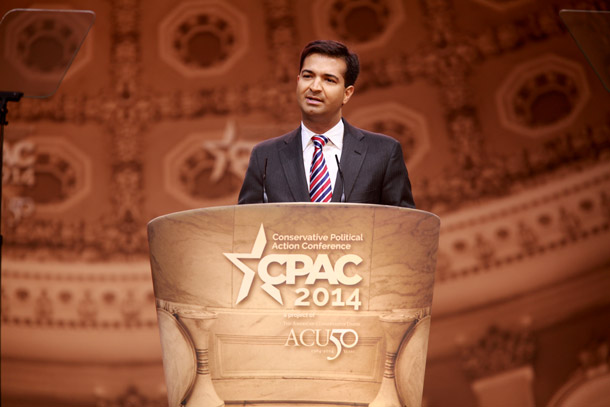
Congressman Carlos Curbelo (R-FL). (Photo: Gage Skidmore, Flickr CC BY-SA 2.0)
CURWOOD: From PRI, and the Jennifer and Ted Stanley Studios at the University of Massachusetts Boston, this is Living on Earth. I’m Steve Curwood.
For years there has been something of a partisan divide in America about global warming, with key Republican leaders in Congress denying outright that humans are having a deadly impact on the climate. So the creation of a bipartisan Climate Solutions Caucus in the House last year marked a turning point, and, with so much of the US reeling from the intensified hurricanes and wildfires, its numbers are growing. Its GOP leader was recently honored for his public service by the John F Kennedy Library in a ceremony at Harvard, and I chatted with him afterward.
CURWOOD: With me now is Carlos Curbelo. He's a Republican Congressman from the 26th district of Florida, which I guess covers Miami south to the Keys, huh?
CURBELO: So, it's the southern tip of the state of Florida, southwestern Miami and then all of the Florida Keys, all the way down to Key West, 90 miles away from Cuba. Beautiful district. Come and visit.
CURWOOD: So, you are the co-chair of the Climate Solutions Caucus in the Congress, a bipartisan group of up to how many Republicans now?
CURBELO: Thirty-one Republicans and 31 Democrats.
CURWOOD: And how does this work?
CURBELO: So, the initial goal of the Caucus - and I thank Congressman Ted Deutsch, also from Florida because he's my co-chair, and we work very well together - our initial goal was to de-politicize this issue. The polarization was out of control. Many Republicans refused to even acknowledge the issue at all. So, Ted and I, with the support of friends from Citizens' Climate Lobby, realized that we needed to change this dynamic, that the current dynamic was not going to lead us to a good place. So, we formed a Caucus and we implemented something that's fairly unique in Congressional Caucuses - although now it's growing in popularity - which is the Noah's Ark rule. You can only join the Caucus if you join with a member from the other party. So, that gives us the benefit of having a very elegant, perfectly symmetrical Caucus which is nice, but more importantly it encourages many conversations between members.
When a member, especially a Democrat, is recruiting a Republican, he or she typically has to go to three or four different people, and then someone else will go to them, and people realize that this is an important issue, and that they're being recruited, and they start paying more and more attention, and it's created this buzz within the Congress where I get many of my very conservative Republican colleagues who come up to me and say, “Hey, tell me a little more about this Caucus. What are you doing?" They're interested. Some of them haven't joined yet. Some have, but the key is, we're getting the word out, and we're growing in numbers.
CURWOOD: So, these conservatives take that word a little further to conservation, huh?
CURBELO: That's right and our most recent addition was Matt Gates, and I want to give him great credit because he is also from Florida, but you know Florida there's like five states in one. He is up from the panhandle, lower Alabama, which is much different than Miami. His district is very conservative, but I told Matt, I said, "Hey, do you recognize that climate change is real?” “Yes, yes I do,” and “Do you recognize that human activity is responsible for at least a significant part of it?" And he said, "Absolutely," and I said, "You're in if you can acknowledge that and you're willing to work with us, welcome." And he joined and of course a Democrat joined with him, and we hope to see more members from those kinds of districts because this is not a political issue. This is an environmental issue. This is a human issue that is having an impact on human lives and needs to be addressed.

The Climate Solutions Caucus was founded in partnership with Congressman Ted Deutch (D-FL). (Photo: Citizens Climate Lobby)
CURWOOD: What has the Caucus accomplished so far?
CURBELO: So, our first phase was to start this dialogue, and dialogue is nice. It's absent in much of our politics, so I don't want to diminish that but quite frankly that's not enough. We got together, we had frank conversations. We exchanged our perspectives. We brought in witnesses to talk to us, the people from energy companies, environmental groups, just a broad spectrum of witnesses that informally came in and share their perspectives. So, that was phase one. It was a success, and now we're currently in phase two of the Caucus, and of this is what I call the “blocking and tackling” phase. Whenever we see bad policy that is coming to the House floor we mobilize - or maybe even in committee but for now it's only been on the House floor - to defeat amendments or laws that we consider to be anti-climate or that don't advance a clean energy agenda.
So, in the summer of this year, we had a colleague from Pennsylvania who filed an amendment that would have prohibited the Defense Department from taking climate change into account, sea level rise, when assessing risks to their facilities. Now, General Mattis who's the secretary of the Department of Defense is on the record acknowledging climate change, stating that it requires a whole of government response. So, we mobilized all of the members of the Caucus except one which, I got to figure out what happened - Maybe he just made a mistake when pressing the button - but all of the members of the Caucus voted to block this amendment. And it may seem like not such a big deal, but it is. It was one of the first times, if not the first, that this type of policy was defeated on the House floor, and I think that without the Climate Solutions Caucus that probably would not have happened.
So, this is the phase we're in now. We want to get better at it and eventually transition into proposing major policy that could address this issue.
We've had other small wins. In the tax bill we extended solar tax credits, most or some wind tax credits. We included some orphan renewable technologies that didn't get included in the 2015 tax bill, so we had some small wins there, but we need to start working towards at least one really big one.
CURWOOD: Congressman Curbelo, I want to switch now to the question the problem, the sorrow of Puerto Rico. Puerto Rico's encounter with Hurricane Maria is linked to climate disruption. It's six weeks after this happened, and yet conditions in Puerto Rico are still dire. The infrastructure is still in tatters. What can Congress do to help? What can your Caucus do the help?
CURBELO: So, first on climate change, definitely the intensity of Hurricane Maria, the intensity of Hurricane Irma were fueled by warmer ocean temperatures. I don't want people to think that I'm saying that hurricanes are a result of climate change because we've had them in Florida for hundreds of years, so that's just an important distinction I like to make to preserve the credibility of our movement and of our efforts.
Now, there's not enough we can do for Puerto Rico. I think the initial response was a little slow and then got better. I also think we have to acknowledge that the logistical nightmare was of a proportion that we had probably never seen. This is a small island. It's far from the mainland. It already had subpar infrastructure, so a lot of goods were being delivered to the island but there was no way to distribute them, and I wouldn't say that's anyone's fault. That's just a result of the circumstances, but we need to do more.
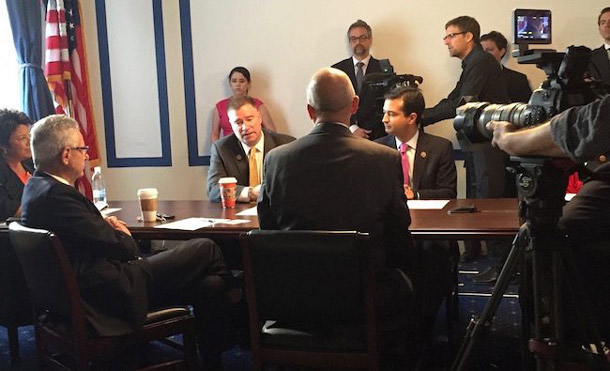
The first-ever climate caucus meeting in 2016. (Photo: Climate Solutions Caucus)
We filed a tax relief bill for Puerto Rico which is going to help people there put more money in their pockets. In this major tax reform legislation we have a rum cover over provision which essentially just injects proceeds from excise taxes on rum back into the Puerto Rico treasury to give them more resources. We also extended a domestic production tax credit for companies that are employing people there, but none of this is enough, and actually after I spoke on the tax bill I asked for a colloquy with Chairman Brady, the chairman of the House Ways and Means Committee, to get his commitment on record that we need to do a lot more vis-a-vis tax policy. Now, this is apart from supplemental appropriations which are coming. A big request is coming, but in addition to that we need to do more through tax policy to help Puerto Rico. We are receiving many Puerto Ricans in Florida already, over 100,000. We are happy to receive them. They fit right into our state.
CURWOOD: Wait a second. They're going to be Democrats!
CURBELO: Puerto Ricans and, I think, all Hispanics are free agents. Trust me. I know. They will vote for the best person, and in some elections that will be a Democrat, but I would argue that in some elections, that will be specifically mine, that would be a Republican.
CURWOOD: [LAUGHS]
CURBELO: So we do welcome them but we don't want them to have to desperately flee the island. For those who do want to make their future in Puerto Rico we want them to have that option, and plus this is an important territory of the United States, and we should invest adequately in it.
CURWOOD: Two more questions. One, Puerto Rico is a territory of the United States. What about the question of statehood? Some say that Puerto Rico’s recovery might have been faster if it were a state rather than just a territory.
CURBELLO: I support statehood. I actually have filed now, for the second Congress in a row, legislation to give Puerto Ricans that opportunity. They have already voted. There was a recent referendum and overwhelmingly they voted for statehood. I think they should become a state, and I agree that they would not have all of the challenges they have if they were a state. For one, states aren't allowed to run budget deficits, and Puerto Rico got itself over $70 billion into debt by having chronic budget deficits. So, right there you'd have a major improvement, and obviously they would just - and all of their social programs like Medicaid, the earned income tax credit in the tax code - they would be treated fairly and equally. So, I'm supportive. We need to build momentum for that cause in Congress.
CURWOOD: And before you go, the Bonn Climate Summit just wrapped up. What kind of future do you see for the United States in the UN climate process?
CURBELO: Well, obviously we have a lot of work to do with this administration. I’ve said over and over again that this administration is leaving a vacuum of leadership in the area of climate change, environmental policy. What I proposed to my colleagues, of course, we need to criticize it, and we have, but instead of just doing that, let's also try to fill that vacuum in leadership that's being left through Congressional action by showing that, if the executive won't lead on this issue, Congress will through appropriations, through tax policy, and also through other legislation.
I think that's the best we can do for now and continue working with some members of the administration who are on record supporting us staying in the Paris Agreement, like Gary Cohn, Secretary Tillerson, I think Secretary [of Defense James] Mattis as well. These people are in power, they are close to the president, and, you know, from what I've seen, the president is fairly flexible in at least some of his views, and I don't have a lot of hope that he can be convinced, but as long as these people that are close to him are there, let's continue working with them to see if we can move things in a better direction.
CURWOOD: Carlos Curbelo is a member of the US Congress from South Florida. Thank you so much for taking the time for us.
CURBELO: My pleasure. Any time.
Related links:
- U.S. Rep. Carlos Curbelo’s Website
- Climate Solutions Caucus
[MUSIC: Gary Burton & Chick Corea, “Love Castle” on Native Sense, composed by Gary Burton, Concord Records]
CURWOOD: Coming up, A small college takes a giant step to go carbon neutral. That’s just ahead on Living on Earth, stay with us!
ANNOUNCER: Support for Living on Earth comes from the Gordon and Betty Moore Foundation, and from a friend of Sailors for the Sea, working with boaters to restore ocean health.
[CUTAWAY MUSIC: Gary Burton & Chick Corea, “Love Castle” on Native Sense, composed by Gary Burton, Concord Records]
The Tesla Truck

The Tesla Electric Truck. (Photo: Courtesy of Tesla)
CURWOOD: It’s Living on Earth, I’m Steve Curwood.
If celebrated innovator Elon Musk has his way, maybe someday you won’t get caught behind a huge 18-wheeler belching a choking column of black smoke as it grinds up a steep hill. That’s because Mr. Musk has unveiled an electric truck that can pull 80,000 pounds quickly over hilly terrain. When it’s released in 2019, it’ll cost about the same as a diesel-powered big rig, but he claims operating costs will be 20 percent lower. Elon Musk is famous as the CEO of Tesla electric cars and Space X, but his vision for the Tesla electric truck is down-to-earth in a big way, as tractor trailers transport 80 percent of goods in the US and burn 28 billion gallons of fuel a year. An electric trucking fleet would fight global warming and local pollution.
Marco della Cava is a technology reporter for USA Today who focuses on the future of transportation. Welcome to Living on Earth, Marco,
DELLA CAVA: Thanks for having me.
CURWOOD: So, what was it like at they recent unveiling of the Tesla semi-truck in California.
DELLA CAVA: Well, it happened down in Los Angeles right next to their Space X headquarters, his rocket company, at a private aviation facility, so you see all sorts of, you know, cool private jets flying by, and, long story short, it really felt like a rock concert. I think he was blasting the Beastie Boys most of the time.
CURWOOD: Hey, what does this truck look like?
DELLA CAVA: Well, it's the cab of a truck -- right? -- that then drags the trailer. It's incredibly sleek, very, very aerodynamic. There are photos of it up online, and it just looks like a regular truck but as if Batman had designed it, to be honest.
CURWOOD: [LAUGHS] I understand you got a tour of the truck itself and got to peek inside. What can you tell us about that?
DELLA CAVA: Yeah, well I did. Shortly before the big event started, a few of us were taken backstage, as it were, and we were allowed to go into the truck. It's very spacious inside, and the most notable feature, because there's no engine, is that the seat for the driver is centrally located, and it's all the way up forward. So, you have this kind of, almost captain's view of the world because you're not looking over a big long hood. You're actually looking at the road, and you've got two kind of almost like iPad screens left and right with all the information you might need. You have a steering wheel and that was pretty much it. There was a jump seat off back to the right for a second passenger, but a lot of room inside and again this centrally mounted driving position was really a novelty.
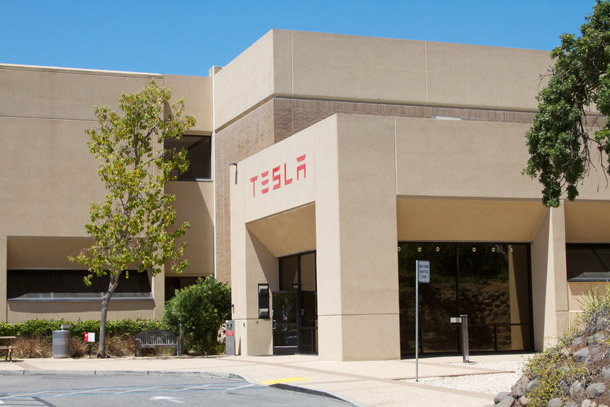
Tesla is headquartered in Palo Alto, California. (Photo: Windell Oskay, Flickr CC BY 2.0)
CURWOOD: Now, a number of companies have already pre-ordered these Tesla trucks for their fleet. Who are these companies, and what's attracting them to this particular electric truck?
DELLA CAVA: Well, pretty quickly, the next day, Wal-Mart and JB Hunt, which is a transportation company, announced that they had placed orders for, I think, roughly a dozen or so of these trucks. That's about a $2 million dollar investment for these companies.
My personal feeling is it's a no-brainer. For a company like Wal-Mart investing a couple million dollars in cutting-edge technology, it might even be worth that alone in publicity, to sort of say that you know you're trying to go green with your fleet, and the things certainly look arresting on the road.
So, I think they're just going with it because there's a lower barrier to entry, financially. I think it's another story to have Joe and Jane Trucker consider maybe buying these.
CURWOOD: So, talk about the kind of shipments that this truck is designed for. What would Wal-Mart or JB Hunt want to use these for?
DELLA CAVA: Well, my - I'm not a trucking world expert, but I would guess that it's from distribution centers to major populations. So, let's say you've got an Amazon distribution center in the middle of sort of rural California or rural Nevada, and you've got to get stuff to Los Angeles or to San Francisco. There, you're talking about 250 miles roughly each way. It's that sort of a run that we're talking about.
The main issues are around re-charging these things. You cannot just plug them into your power outlet at home, which you can with a Tesla. It might take all night to charge, but you can do it. These things have many more batteries, and they're powering many more transmission-type parts and essentially he would need to create a totally different super charger system just dedicated to trucks, and that's why he said that the 500-mile range was created so that most truck drivers who drive this size truck are doing routes that are under 250-miles each way. So, what he's implying is, yes, we will get these charging stations put up, but in the short term you could buy these and do what you normally do and get home on that one charge.
CURWOOD: Well, let's talk about the “why” for an electric truck. There are a whole bunch of them. What's the first one that comes to you? Why an electric truck?
DELLA CAVA: You know, it's been said to me by a variety of sort of industry experts that the Tesla truck might look cool, but nobody cares in the trucking world. They just care about, how much does it cost per mile to operate your truck. And Musk seems to understand that because during his presentation he threw up slides that indicated that running his trucks on a given route versus a standard diesel truck would cost you in the order of 20 percent less per mile, and that's what's supposed to grab people's attention, is basically the cost savings.
CURWOOD: I understand, if this is a Tesla, if this is a Musk-mobile, there will be some autonomous features. What are they on this truck, and how do they attempt to appeal to truck drivers and owners?

Walmart has ordered 15 of Tesla’s new semi-trucks. The company is one of many that already deploy hybrid cars for some of their deliveries. (Photo: Walmart, Flickr CC BY 2.0)
DELLA CAVA: Well, that is an interesting and a totally different question and some truckers are leery of it. They don't want to be replaced, needless to say. In this case, Musk said that the trucks would have autopilot, which is a standard feature on Tesla cars, and in particular he again threw up a video illustration of three trucks in a convoy. The trucks would be closely following each other using autopilot technology to stay a certain distance apart and just convoying for hundreds of miles. He threw that up there, not so much to show off the autopilot, but to point out that additional cost per mile savings would be available when three or so of his trucks convoy together.
CURWOOD: So, where are the traditional truck makers on the notion of electric truck? What are those guys doing? I mean, when Musk got Tesla going, suddenly there are 30 interesting electric cars that have come on the market in his wake.
DELLA CAVA: I think you might see the same sort of trickle-down effect but also not anything immediate. A lot of people in the traditional trucking world argue that diesel is a perfectly suitable means by which to power a truck. They've gotten it down to the point where you could certainly get a lot of miles to the gallon that route, and I think their argument is, why fix something that isn't broken.

Marco Della Cava is a Technology Reporter for USA today. (Photo: USA Today)
CURWOOD: Of course people who are concerned about climate disruption would say, the climate's broken. Every molecule of CO2 makes a difference.
DELLA CAVA: Yeah, I interviewed a guy named Ian Wright, actually he was one of the founders of Tesla before Musk came around, and Ian has gone on to found a company called Right Speed. And Right Speed works on retrofitting buses and garbage trucks with electric engines. And when I asked him his reaction to this latest Musk extravaganza, he said, "It's about time," and I said, "Why?", and he said, "Because if you really care about the environment, forget about changing cars to electric cars. They're not even by orders of magnitude the worst offenders. These trucks are, and that's what he should be working on." So there's certainly a case to be made, and I think the good news is that if truckers see that they can make more money this way, they're going to inherently consider it.
CURWOOD: Marco Della Cava is a technology in transportation reporter for USA Today. Thank you.
DELLA CAVA: Thanks for having me.
Related links:
- USA TODAY: “Tesla Semi, an electric big rig truck with 500-mile range, rolls into reality”
- The Tesla Semi-Truck
[MUSIC: Glenn Miller and the Army Air Force Band, “Jeep Jockey Jump” on Glenn Miller & the Army Air Force Band, composed by Jerry Gray, Laserlight Digital]
100% Sun Power for Hampshire College
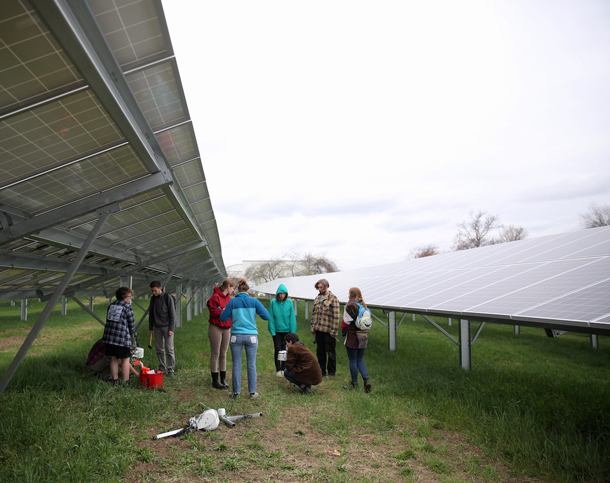
Hampshire College is the first residential U.S. college to go 100% solar for electricity. The 19-acre solar panel array was built on part of the campus’s open agricultural land. (Photo: Courtesy of Hampshire College)
CURWOOD: More than 800 colleges and universities in the US are taking steps to fight global warming, but only one residential campus so far has gone 100% renewable for its electricity, Hampshire College in Western Massachusetts. Hampshire was founded as a counter-culture school during the 1960’s with optional ‘do you own thing’ courses designed by students and a strong environmental focus. Indeed the school mascot is a frog, atonement, legend has it, for wetlands drained for its first buildings.
A few years ago Hampshire College recruited former World Resources Institute head Jonathan Lash to be its president, and his tenure has seen everything from net zero energy buildings to a brand-new, 19-acre solar-power system that has just come on line. Jonathan Lash joins us now. Welcome to Living on Earth.
LASH: Thank you. Glad to be here.
CURWOOD: Tell us, how is Hampshire College going 100 percent solar for electricity?
LASH: We installed 19 acres of solar collectors, about 15,000 panels, and those panels will produce 4.7 megawatts of power a year. That's more than the college uses. We’re hooked up to the grid, so in the dark of night, in the middle of winter, there is still power flowing to all our students' devices, but on a July day we'll produce a lot more power than we'll use, and that means on an annual basis we’ll produce more power than the school uses.
CURWOOD: Nineteen acres. Now, the cynics would say what about all those trees that had to die for the solar array?
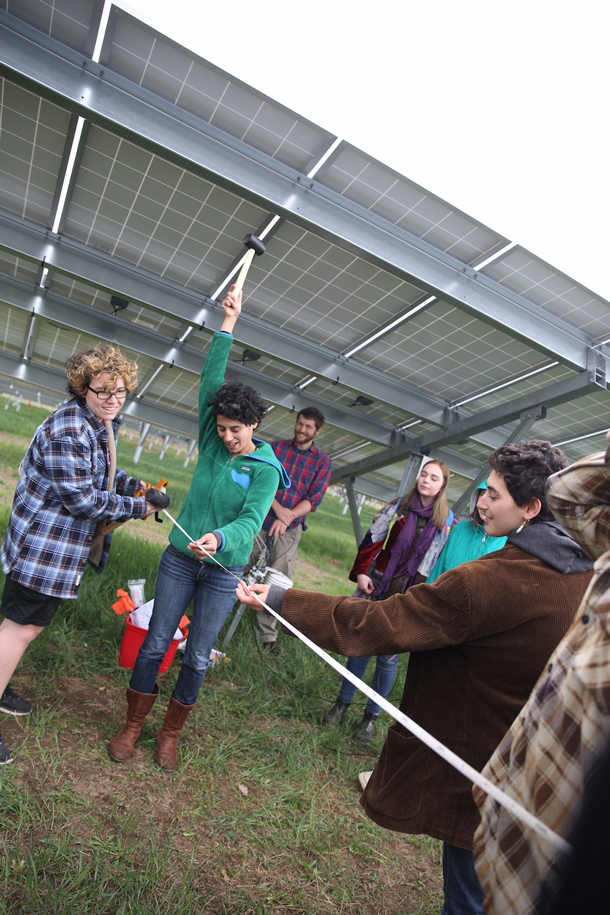
Students at Hampshire College conduct research around the newly-installed solar panel array. (Photo: Courtesy of Hampshire College)
LASH: That's a really interesting question actually, Steve. Our students were deeply involved in selecting the sites. We have an 800-plus acre campus, and a lot of it is agricultural land, fields that we mow for hay, use to grow vegetables, and we ended up choosing to use open ag land so we would not have to cut trees, and we have a group of students who have been doing research with one of their professors to determine whether, in fact, installing collectors has any long term, negative impact on that land.
CURWOOD: Hey, what do 19 acres of solar panels look like?
LASH: It's pretty hard to see them because they're set back on agricultural fields. They're not in your face. We had a committee of students, faculty, and staff who worked with our neighbors to assure we took their concerns into account, and one of the results is that the fields of panels are pretty well screened from the road, from nearby homes. It's a big expanse of large, reflective panels. If you look down on it from the air, it would attract your attention. If you look over at it from next door, you wouldn't see it.
CURWOOD: So, how does the solar energy system there at Hampshire College compare with what other colleges and universities are doing?
LASH: This is a great story that people don't know about. There are a lot of colleges and universities around the country who have decided to just get on with it. Some of their systems are bigger than ours. We're pretty proud that we decided to go 100 percent and that it's a little, not very well resourced college out in snow country that's able to do this.
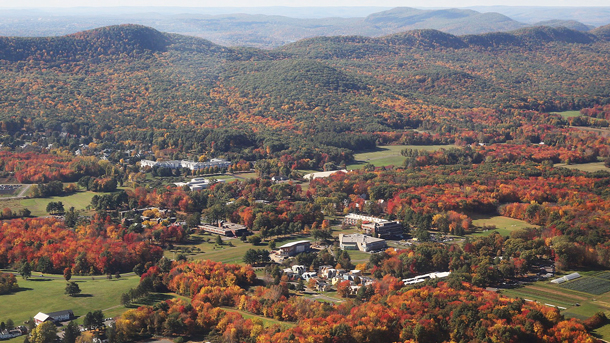
Hampshire College is part of a Five College Consortium in what’s known as the “Pioneer Valley” of Massachusetts, along with Amherst College, Smith College, Mount Holyoke College and the University of Massachusetts Amherst. (Photo: Courtesy of Hampshire College)
CURWOOD: So, let's talk about the economics of your switch? How much did it cost you upfront, and over the long term what do you think the economics will be?
LASH: We've contracted with SolarCity. SolarCity is paying to install the panels for us. We supplied the land, and we've signed a contract to buy all the power coming from the panels. We pay them a little over six cents a kilowatt hour. If we buy the electricity from the grid, we pay about thirteen and a half cents a kilowatt hour, so it's a big savings. And in the evening in winter, when our utility experiences peak demand, we pay over 30 cents a kilowatt hour, so the installer, Solar City, has supplied us with a bank of Tesla batteries that enable us to rely on the solar power stored in the batteries, rather than buy expensive power on an evening when everybody is using electricity. That's good for us and it's actually helpful for the utility.
CURWOOD: And you would pay that 30 cents to SolarCity or to the grid folks?
LASH: We pay that to the grid folks. If we buy power from them, we pay them. If we sell power to them, they pay us.
CURWOOD: We should mention by the way that SolarCity is an underwriter of living on Earth. So what set this plan in motion?
LASH: Well, my background has been as an environmental advocate for the last 40 years, and when I got to Hampshire, the school was already thinking about how to become greener and had in place a commitment to reduce its greenhouse gas emissions. We took a look in 2012 at whether we could install solar, and it looked too expensive. Now, we looked again in 2015 and the price had come down so much, the efficiency of the panels had gone up so much, that we were able to move forward and have it be an overall savings rather than an expense for the college. We would do this just for economic reasons, but there are a lot of other reasons as well.
CURWOOD: How do you think the Hampshire College is going to benefit now from this switch?
LASH: The most important aspect of this for us is as part of the curriculum. Students were involved in every part of the decision, from the research that determined that, in fact, we were going to save money, to the choice of a contractor, to the selection of a site, working with neighbors, and now overseeing the management of the system. This is the challenge that our students and every other student is going to face in the next 20 years, how to turn the U.S. economy into a low carbon economy, and they're going to get the real first-hand experience of doing it. So that was reason number one.
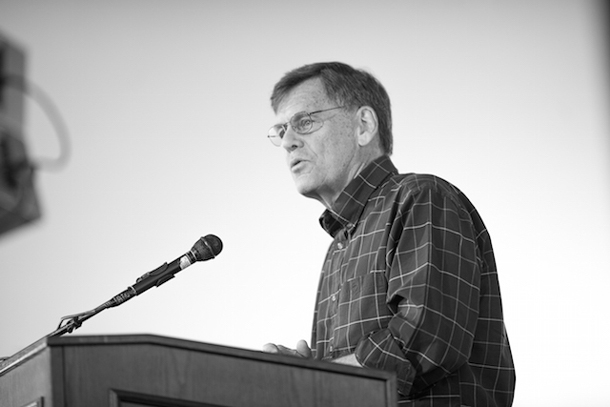
Before coming to Hampshire College, Jonathan Lash was president of the World Resources Institute, a Washington-based environmental think tank. (Photo: Courtesy of Hampshire College)
Reason number two is the economic benefit. We'll save $8 to $10 million dollars over the life of this system for Hampshire College. That's a big deal. It's really important.
Third reason is it's just the right thing to do in an era of accelerating climate change. This keeps the jobs local. It means that there are no pipelines being built through people's communities to get power to our college, and it helps, in the best way that we can, to avert climate change, the costs of which are falling most heavily on the poorest, most vulnerable people.
CURWOOD: So, Jonathan, hey, congratulations on putting all this together, using the sun.
Jonathan Lash is the president of Hampshire College. Thanks so much for taking the time with me today.
LASH: It was good to be with you.
Related links:
- Hampshire College
- Jonathan Lash, “Accepting The Challenge For Climate Action” in The Huffington Post
- Jonathan Lash Bio
[MUSIC: The Beatles, “Here Comes the Sun” on Abbey Road, composed by George Harrison, Apple Records]
Beyond The Headlines

A California National Guard helicopter works to fight a 2010 wildfire near Cherry Lake. In 2015, wildfires on the state’s federal lands produced about 23 million metric tons of greenhouse gases. (Photo: California National Guard, Flickr CC BY 2.0)
CURWOOD: Time now to look at the world beyond the headlines with Peter Dykstra. Peter’s an editor with DailyClimate dot org and Environmental Health News -- That’s EHN dot org -- and he’s on the line from Atlanta, Georgia. Hey, what’s going on, Peter?
DYKSTRA: Hi Steve. Let's start with a case of good news that's almost literally burned away by the bad news. In 2015, the state of California's aggressive efforts to cut greenhouse gas emissions yielded a cut of 1.5 million metric tons over the previous year, which is a sign of great progress, except for this. California's biggest wild fire that year, in Fresno County, added over four times the greenhouse gases the state managed to cut, 6.8 million metric tons from that one fire alone.
CURWOOD: Whoa! So, it's like one step forward, and four steps backward, huh?
DYKSTRA: Exactly, and on federal lands alone California wildfires added 23 million metric tons of GHGs that year.
CURWOOD: And this year we had huge blazes in wine country and in Southern California.

Outfall rumbles into the Hattiesburg South Sewage Lagoon in Mississippi. Researchers from the American Chemical Society are developing ways to extract useful chemicals from sewage like this. (Photo: Gulf Restoration Network, Flickr CC BY-NC 2.0)
DYKSTRA: Yeah, and in the wake of these fires, we rightfully focus on the immediate human tragedy, the loss of life, the loss of property, but there's long term damage that's much more difficult to focus on if the fires are getting more frequent as a greenhouse gas threat.
CURWOOD: And the situation would obviously be even worse if California hadn’t been cutting its emissions so energetically. Hey, what do you have next for us?
DYKSTRA: I’ve got news from the American Chemical Society. Researchers are finding ways to recover useful and valuable chemicals from -- Wait for it -- our own sewage.
CURWOOD: Oh yeah, Peter, I’m sure you have all the poop.
DYKSTRA: No, I just have my fair share. But phosphorus, cellulose, fertilizers, biofuels, and biodegradable plastics are just some of the industrial products that could be gained if the challenges of working with municipal waste are overcome.
CURWOOD: And those challenges would be…?
DYKSTRA: Filtering out the good stuff from a stream that's still about 99% water, and of course sewage has an unsavory reputation as well.
CURWOOD: Yeah, but Peter, maybe the smell of money will overcome that other smell. Hey, let's talk a look back now at environmental history. What do you have for us this week?
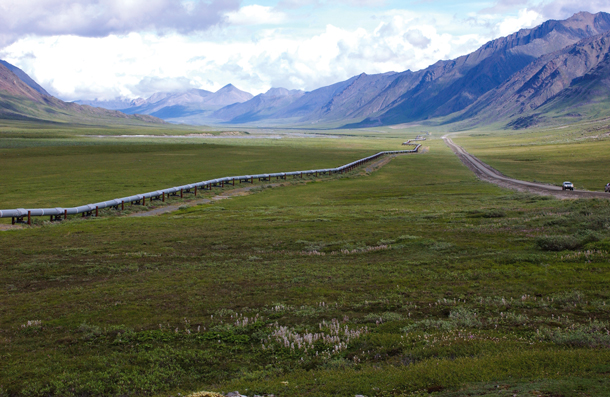
The Trans-Alaska Pipeline covers 800 miles of the state’s vast interior. Only a few years after its construction, President Jimmy Carter signed the Alaska Lands Bill, which set aside almost 80 million acres of land for conservation. (Photo: U.S. Geological Survey)
DYKSTRA: December 2, 1980, President Jimmy Carter signed the Alaska Lands Bill, after it passed Congress with strong bipartisan support. At the time, it was considered a bold stroke for conservation. The Alaska Pipeline had started up a few years earlier, opening up a bonanza of oil production on the North Slope, so Congress and the President set aside nearly 80 million acres in the northern half of the state as protected land. That's an area about four-fifths the size of the state of California, with about a third of that land designated as wilderness.
CURWOOD: Yeah, it’s huge in both size and significance, but, Peter, I can't imagine that it would pass muster with today's Congress.
DYKSTRA: Or today’s President. In fact, Senator Lisa Murkowski of Alaska has proposed opening up one of the longest-running conservation battles in history with a measure to allow oil and gas drilling in the Arctic National Wildlife Refuge. And remember when President Obama banned drilling in the Arctic Ocean? Well, a Trump administration agency approved an Arctic Ocean drilling site at the end of November.
CURWOOD: Peter Dykstra is with Environmental Health News. That’s EHN dot org and Daily Climate dot org. Thanks a lot Peter.
DYKSTRA: Ok Steve, thanks a lot. We’ll talk to you soon.
CURWOOD: And there’s more on all these stories at our website, LOE dot org
Related links:
- San Francisco Chronicle editorial: “California fires’ overlooked consequences”
- Chemical and Engineering News: “Tapping sewage as a source of useful materials”
- Jimmy Carter signed the Alaska Lands Bill in 1980
[MUSIC: Brian Shaw, “Solitude,” live recording from the Hot Summer Nights and Cool Jazz series in June 2012, Louisiana State University, LSU School of Music Recital Hall, composed by Duke Ellington]
CURWOOD: Coming up, why evolution can be a matter of chance or destiny or both. That’s just ahead here on Living on Earth. Stay tuned.
ANNOUNCER: Funding for Living on Earth comes from you our listeners, and United Technologies - combining passion for science with engineering to create solutions designed for sustainability in aerospace, building industries and food refrigeration. UTC companies such as Otis, Carrier, Pratt & Whitney and UTC Aerospace Systems are helping to move the world forward. You can learn more about United Technologies by tuning in to the Race to 9 Billion podcast, hosted by UTC’s Chief Sustainability Officer. Listen at raceto9billion.com. That’s raceto9billion.com.
This is PRI, Public Radio International.
[CUTAWAY MUSIC: Brian Shaw/Willis Delony/Bill Grimes/Troy Davis, “Solitude,” live recording from the Hot Summer Nights and Cool Jazz series in June 2012, Louisiana State University, LSU School of Music Recital Hall, composed by Duke Ellington]
Improbable Destinies: Fate, Chance, and the Future of Evolution
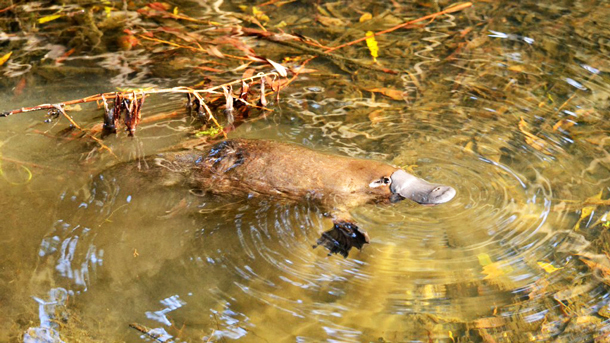
The duck-billed platypus is an extraordinarily well-adapted creature unlike anything else in the animal kingdom – despite the fact that the kinds of streams where it lives are hardly unique to Australia. (Photo: Klaus, Wikimedia Commons)
CURWOOD It’s Living on Earth, I’m Steve Curwood.
Ask someone about evolution, and they’ll likely point to Charles Darwin, his finches, and the survival of the fittest. Asked if evolution is inevitable, some might note the role of chance, such as the giant asteroid that killed off the dinosaurs.
And now there is a new book by evolutionary biologist Jonathan Losos that considers the roles of both chance and inevitability in how species evolve. It’s called Improbable Destinies -- Fate, Chance and the Future of Evolution. Jonathan Losos is the curator of herpetology, lizards and the like, at the Harvard Museum of Comparative Zoology, and Living on Earth’s Helen Palmer went to meet him in his office there.
PALMER: Jonathan Losos, the subtitle of your book, "Improbable Destinies”, is “Fate, Chance and the Future of Evolution". To leave aside the future for a minute and look at the past, is evolution fate or chance?
LOSOS: Well, it's some of both, but I think there's a large component of chance, that if events had happened differently in Earth's past, I think evolution very likely would have taken a different course, and the outcome might be very different from what we see today. If the dinosaurs hadn't been wiped out by that asteroid, I think it's very reasonable to say that they would still be here today, and if the dinosaurs were here today, it seemed reasonable that we - we being mammals - would still be skulking in the underbrush like little possums or rats.
PALMER: Is it inevitable that there would have been a superior, bigger brained race of some kind on the Earth? Is that kind of evolution that the fittest survive, and it becomes more and more complex, is that kind of evolution inevitable?
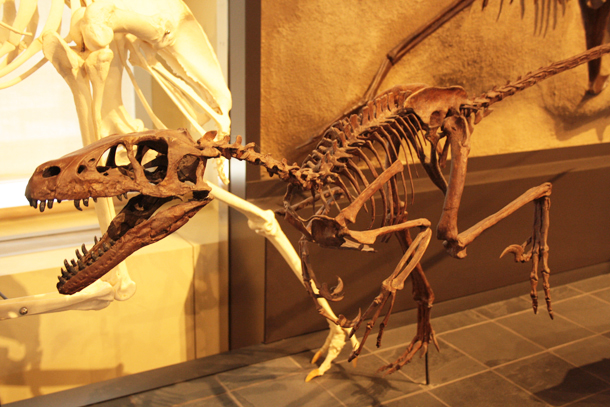
With its relatively large brain, Velociraptor was probably pretty clever, and had it not been wiped out with all the other dinosaurs 66 million years ago, Losos says it’s very possible Velociraptor’s brain would have continued to grow. (Photo: Shankar s., Flickr CC BY 2.0)
LOSOS: Well, that's a great question, and that's one that's been debated for a long time. We can well imagine that there is an advantage to being more intelligent, and so that natural selection may well favor organisms with bigger brains that are smarter. And so, if the asteroid hadn't wiped out the dinosaurs, well maybe it's the dinosaurs that would have evolved to become more and more intelligent. If you recall Velociraptor, everyone's favorite or maybe not their favorite from Jurassic Park, where they were portrayed as being pretty intelligent – Remember, they outwitted the Safari Hunter, and they could open doors, and they were very clever, and that's because by dinosaur standards they had pretty large brains. If those animals had survived, and if natural selection had continued to favor the most intelligent of them, we can imagine that dinosaurs would have evolved very large brains, perhaps comparable to what we have.
Now, does that mean they would look like us? Probably not. The theropod dinosaurs of Velocity Raptor and Troodon were related to T-Rex and to Allosaurus, and so these were animals that were already bi-pedal, walking on two legs. They had hands that were used for grasping, but they also had a long tail, and so they probably would have continued in that body form and just developed a big head and probably a big tail to balance that head. But the other thing is, they probably had feathers, and so we're now really talking about an animal on two legs with a long tail, grasping hands, a big brain, covered with feathers. Kind of like a super-sized chicken as I think what they would have looked like.
PALMER: [LAUGHS] It's mind-boggling to imagine such a thing actually.
LOSOS: You know, it could have been.
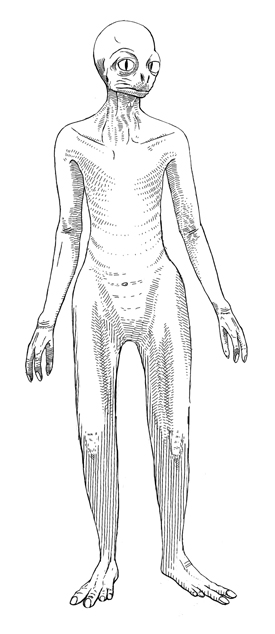
Canadian paleontologist Dale Russell speculated that a modern-day descendant of Troodon, a relative of Velociraptor that was also pretty brainy, would look something like the above illustration; he called it a “dinosauroid.” (Photo: Marlin Peterson)
PALMER: You concentrate on a kind of Caribbean lizard called the anole. Tell me why it's a really good study subject, and tell me what's happened to your own research on it.
LOSOS: Well, anoles are a particularly good organism to study evolution because they're a great evolutionary success story. There are 400 species of them, and you can walk close to them and they will just continue doing what they do and not be too disturbed. Then you can catch them, you can bring them back in the lab. You can study their behavior in the lab. You can study their physiology. We can look at their genetics, at their DNA. How is it that these lizards have gotten to be so successful?
PALMER: You've also discovered that different species on different islands all evolved to take advantage of a particular ecological niche.
LOSOS: Yes, probably the most interesting aspect of these lizards is that on the large islands of the Caribbean - That's Cuba, Puerto Rico, Jamaica and Hispanola - each island, the lizards have diversified independently. That's to say, all the species on Jamaica are descended from a single ancestor, and yet when you look at the species that have been produced, they have produced the same types of habitat specialists.
So, for example, in Puerto Rico, say, you went into the rainforest in the Luquillo mountains before it was flattened by a hurricane -- It will come back -- Anyway, if you went to the rainforest and you sat quietly, after a few minutes the lizards would forget you were there, and you would see that there are a number of different species living in different parts of the habitat. You have one species that lives on the tree trunk near the ground and has very long legs and is very good at running to the ground or jumping to the ground to confront its fellow lizards, or to eat food, or whatever.
You have another species living on twigs, on narrow surfaces. It has very short legs, and it moves very slowly, cautiously, over the narrow irregular surfaces it uses, and it's very well camouflaged because it can't move very fast.
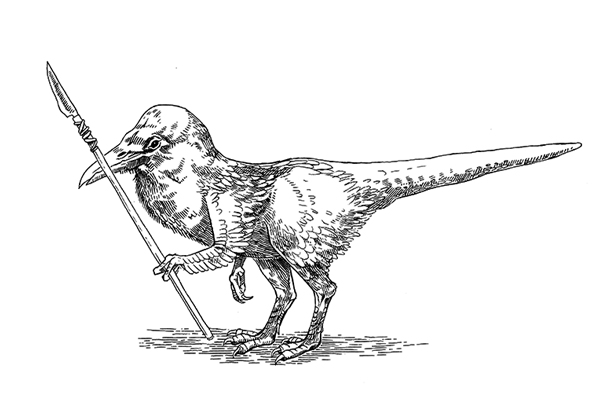
Some evolutionary biologists now propose that if the dinosaurs had survived, it’s not obvious their brainy descendants today would be similar to humans. They might in fact look something like a super-sized brainy chicken. (Photo: Marlin Peterson)
And then high in the tree you have another species. It's green, so it blends in with the vegetation, it has big toe pads that allow it to stick onto, onto the leaves it's hanging out. So, within one place the species have adapted to use different parts of the environment. But the really fascinating thing is that, when you go to another island, you see the same set of habitat specialists. So, you have a twig species almost identical to the one in Puerto Rico, but it's not closely related, and then you've got another one high in the trees, green with big toe pads just like the Puerto Rican one and another one on the ground and so on.
PALMER: But these are actually different species. They're not the same species, sort of like just jumped from one island to another.
LOSOS: No, that's correct. They are different species and the similar ones on different islands are not closely related to each other. When we look at their DNA, that becomes very clear. All the species on Jamaica are more closely related to each other than they are to the similar ones on other islands.
And so what that means is that these twig anoles, as we call them, have evolved four times, once on each island. This is a phenomenon we call convergent evolution when species evolve to be similar, and it's a very old phenomenon. Darwin knew about it, but what's particularly interesting with these lizards is that it's not convergence of a single type, like the twig anoles, but of an entire ensemble of different habitat specialists.
PALMER: In other parts of the world it's not lizard species that evolved to use habitats, it's a totally different species, particularly, if you look at the place like Australia, you point to how very different the fauna is there even though it’s occupying the same kind of spaces as creatures in other parts of the world.

On Jamaica – just like on other Caribbean islands – one species of anole lizards has diversified into four different species (clockwise from top left): Garman’s anole (green guana); Graham’s anole; Jamaican bush anole; Jamaican twig anole. (Photo: Marlin Peterson)
LOSOS: Well, this is one of the debates that I get at, at my book, of how deterministic is evolution, is the same outcome necessarily will occur, and on the islands I study in the Caribbean, it turns out it is pretty deterministic. If you put a lizard on a Caribbean island, it will diversify and produce the same set of species time and time again. On the other hand, that's not always the case. There are species that evolve to adapt to their particular circumstances in ways that no other species has done, and my favorite example of that is the Duck-billed platypus.
Now the duck-billed platypus gets a bad rap. People think it's some ridiculous mishmash of parts that can only survive you know off in Australia where everything is a misfit or something like. That's really completely unfair. The platypus is an extraordinarily well-adapted animal. It lives in streams in Australia, and it has features, well, it's got very thick fur so it can tolerate very cold temperatures. It's got a powerful tail. It's got webbed feet to swim. Its most extraordinary feature, though, is its bill which is covered with receptors that can detect both slight ripples in the water, but even more amazingly it can detect electric discharges, that when a crayfish moves its muscle there's a little discharge, and the platypus can pick that up with its bill and can find the crayfish just by those electric discharges. So, really exquisitely adapted to its environment.
Well the place that it lives, these streams in eastern Australia, streams and ponds, there's nothing special about them. There are streams and ponds like that here in North America and Europe, all over the world and yet nothing like the duck-billed platypus has evolved anywhere else. It's a unique solution to a common problem and so that illustrates that evolution isn't always predictable. You put species in a similar environment, they may not adapt in the same ways.
PALMER: I think most of us, if you ask most people, they would tell you that evolution is a slow process. It's something that works over eons or maybe sometimes, as Stephen Jay Gould suggested, there's this punctuated equilibrium that it's a bit jerky, but typically that it's slow. But you point out that in some cases it actually happens quite fast.
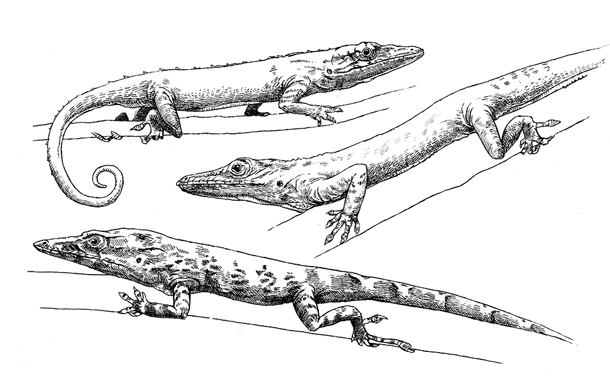
The Caribbean islands of Hispaniola, Puerto Rico, and Cuba all have twig anoles (shown above from top to bottom, respectively) that independently evolved to have very similar features. (Photo: Marlin Peterson)
LOSOS: That's correct. We used to think that evolution was a very slow gradual process, that it took eons, thousands of years, before you could detect the difference, and that idea really traces back to Darwin. Now, Darwin in his day had no direct evidence about evolution in nature. It was his intuition that led him to believe that evolution would occur slowly. Darwin was right about a remarkable number of ideas he had, from evolution by natural selection to how atolls are formed to how worms produce mold. And so, when Darwin said something, we tend to assume he got it right.
It turns out, this is one example where he didn't. We now know that, when natural selection is strong, evolution can occur very rapidly. And now evolutionary biologists, actually the expectation is that, when environments change, we will see rapid evolution, and of course, the environment is changing radically right now, thanks to all the ways we're changing the world, and so it's not surprising to think that evolution could be occurring very rapidly even right around us.
PALMER: And your experiments with anoles and the leg length demonstrates that it can happen very fast because the ones with longer legs were falling off the twigs, for instance, and didn't survive.
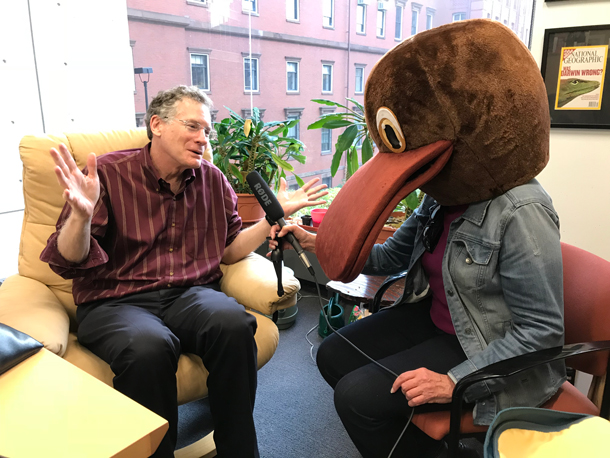
In addition to lizards, Jonathan Losos likes platypuses so much that his office is crawling with plush platypuses, small figurines and a gigantic custom-made platypus costume (worn in the above photo by Living on Earth’s Helen Palmer). (Photo: Jenni Doering)
LOSOS: Exactly. Since we know that evolution can occur rapidly, that means we can actually do experiments on evolution, something that that Darwin, who was a great experiment, never even considered. So, some people are actually setting up experiments, changing conditions and seeing if they can observe evolution in real time.
And that's what we did with lizards. We put them in a situation where we thought that natural selection would favor shorter legs, and we asked, over a few years would they actually evolve shorter legs? And the evidence indicates that they do.
PALMER: Fast.
LOSOS: Yes, very fast. A couple of years. So, you can write a five-year grant -- I'm going to look for evolution, and you could reasonably think that you might find it.
PALMER: One of the experiments that you write about, one of the most fascinating experiments is the one that's done at Michigan State by Rich Lenski and his team. Can you explain what that is?
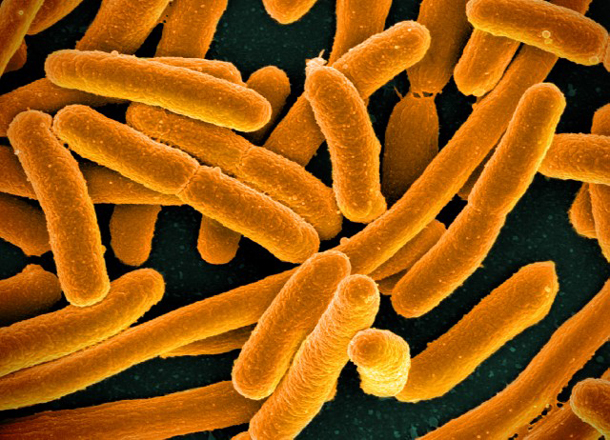
The Long-Term Evolution Experiment, or LTEE, has been running for 30 years now and its 70,000 E. coli generations have produced surprising evolutionary results. (Photo: NIAID, Flickr CC BY 2.0)
LOSOS: Well, this is a spectacular experiment. What Lenski did is, he wanted to ask this question, how repeatable is evolution? How destined is it to produce the same result time and time again?
And so what he did is, he took a strain of E. coli, the bacteria, and put them in a new mixture of nutrients to which they were not well adapted, and so he predicted that the bacteria would have to evolve to adapt to the new conditions. However, he didn't do this with just one test tube of them, actually in a flask, but he made 12 flasks all drawn from the same source, so they were all faced with the same challenge. They started identically. Would they adapt in the same way? He initially planned to do this experiment just for six months or so, but it just was so fascinating he kept on doing it, kept on doing it. Now he's been doing it, he and a lab full of brilliant scientists working with him, they've been doing it for 30 years for 70,000 E. coli generations, and they've watched how these 12 independent replicates have adapted to the same resources.
PALMER: So, exactly what have they found? Have they gone absolutely down parallel tracks?
LOSOS: Well, that's the fascinating thing. For the first 15 years of the experiment, for the most part, the 12 populations did the same thing. There is a little bit of variation. There are some interesting twists, but for the most part you could characterize it as, they are adapting in the same way to the same conditions.
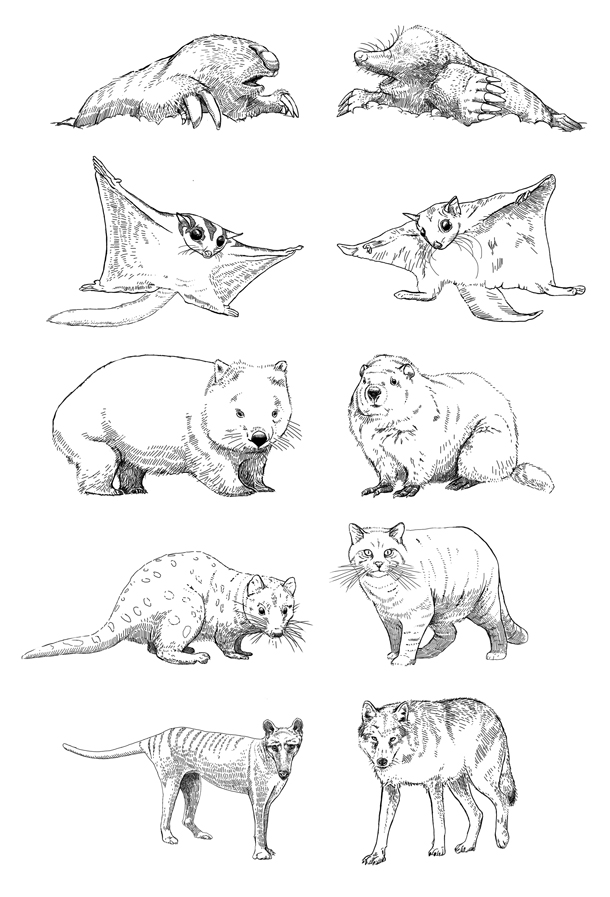
Evolution often produces quite similar kinds of species from entirely different branches of the tree of life. Above, Australian marsupials and their convergent placental counterparts (from top to bottom): marsupial mole—mole; sugar glider—flying squirrel; wombat—groundhog; quoll—wild cat; thylacine—wolf. (Photo: Marlin Peterson)
And then, 15 years into the experiment, one population found a way to adapt to these nutrients in a way that was completely different from any of the other 11 populations, in fact, different from any other E. coli that had been studied in the lab. A vastly different adaptation, so much so that you might consider it a different species. And to this day none of the other 11 populations have found that solution.
So, here's a clear example that evolution isn't always deterministic, that even though the 12 populations started identically, they faced the same circumstances, one of them found a very different way to adapt to the situation.
PALMER: So, how did it do it? Was it sort of like dumb luck? Was it clever reasoning? I mean, what happened was, they were fed glucose, and this one population evolved to use citrate, which was just a stablizer in there, and none of these E. coli can eat citrate except for this one. So how did it do it?
LOSOS: Well, it's a bit complicated in terms of microbiology, but the simple version is this. There was citrate in the nutrients that they were provided, for technical reasons. They weren't expected to eat the citrate. In fact, equal E. coli cannot eat citrate in the presence of oxygen, and so it was just there for other reasons. But this one population found a way to be able to take in the citrate, and the way that happened is that there were at least three mutations that just happened to come along and just happened to come along in the right order, and that they allowed it to change around the molecular machinery in a way that they were able to take the citrate in.
PALMER: So, this is basically an example of chance. It was chance that these mutations happened in the right order.
LOSOS: Exactly.
PALMER: The third part of the book's title is "The Future of Evolution". What is the future of evolution do you think?
LOSOS: Well, you can answer that question in a number of different ways. At one level, evolution is going on all around us. As we said earlier, evolution can occur very rapidly when the environment changes, and we are changing the environment in very many different ways, and so organisms are adapting to these changes, and these evolutionary adaptations actually affect us as well in a variety of ways.
-Riverhead.jpg)
Jonathan Losos is a biology professor and director of the Losos Laboratory at Harvard University and Curator of Herpetology at Harvard’s Museum of Comparative Zoology. (Photo: Rose Lincoln / Riverhead Books)
On the one hand, there are species we consider pests, rats and various insects and various weeds, that we don't like because they inconvenience us or cause us economic hardship or even cause us medical problems. And we try to get rid of them by developing pesticides of various sorts. Well, these rascals are evolving resistance to our efforts often very successfully. We see the same thing with the microbes that are evolving to attack us, and we try to poison them with drugs, antibiotics, and they are evolving resistance, and this is a huge problem because it is killing people. And so, again, this is the result of evolution, species adapting to the measures that we are developing to control them. And so, evolution is going on all around us, and we need to understand it in order to try to shape evolution to our benefit.
And lastly, of course, there are species that are endangered by the changes in the world. Global warming is a real threat. Many species are having trouble at coping with it, and the question is, will they be able to adapt to a warmer world or a world that is drier or whether or or wherever they happen to live? Evolution is not some academic subject that only pointy-headed scientists in their labs care about. It is affecting the world around us and has real consequences for us.
CURWOOD: Jonathan Losos. His book is called Improbable Destinies -- Fate, Chance and the Future of Evolution. He spoke with Living on Earth’s Helen Palmer.
CURWOOD: And join us next time to learn how that tail-wagging, adoring companion of yours can help you live longer. Dogs and human health benefits, next time on Living on Earth.
Related links:
- Improbable Destinies: Fate, Chance, and the Future of Evolution
- The Losos Laboratory at Harvard
- Ars Technica: “Evolution experiment has now followed 68,000 generations of bacteria”
[MUSIC: Paddy Keenan, “Slow Air”]
CURWOOD: Living on Earth is produced by the World Media Foundation. Our crew includes Naomi Arenberg, Bobby Bascomb, Savannah Christiansen, Jenni Doering, Noble Ingram, Jaime Kaiser, Don Lyman, Helen Palmer, Adelaide Chen, and Jolanda Omari. Tom Tiger engineered our show, with help from Jeff Wade and Jake Rego. Alison Lirish Dean composed our themes. You can hear us anytime at LOE.org - and like us, please, on our Facebook page - PRI’s Living on Earth. And we tweet from @LivingonEarth. I'm Steve Curwood. Thanks for listening.
ANNOUNCER1: Funding for Living on Earth comes you, our listeners, and from the University of Massachusetts, Boston, in association with its School for the Environment, developing the next generation of environmental leaders. And from the Grantham Foundation for the protection of the environment, supporting strategic communications and collaboration in solving the world’s most pressing environmental problems. Support also comes from the Energy Foundation, serving the public interest by helping to build a strong, clean, energy economy. From Gilman Ordway, and from SolarCity, America’s solar power provider. SolarCity is dedicated to revolutionizing the way energy is delivered by giving customers a renewable alternative to fossil fuels. Information at 888-997-1703. That’s 888-997-1703.
ANNOUNCER2: PRI. Public Radio International.
Living on Earth wants to hear from you!
Living on Earth
62 Calef Highway, Suite 212
Lee, NH 03861
Telephone: 617-287-4121
E-mail: comments@loe.org
Newsletter [Click here]
Donate to Living on Earth!
Living on Earth is an independent media program and relies entirely on contributions from listeners and institutions supporting public service. Please donate now to preserve an independent environmental voice.
NewsletterLiving on Earth offers a weekly delivery of the show's rundown to your mailbox. Sign up for our newsletter today!
 Sailors For The Sea: Be the change you want to sea.
Sailors For The Sea: Be the change you want to sea.
 The Grantham Foundation for the Protection of the Environment: Committed to protecting and improving the health of the global environment.
The Grantham Foundation for the Protection of the Environment: Committed to protecting and improving the health of the global environment.
 Contribute to Living on Earth and receive, as our gift to you, an archival print of one of Mark Seth Lender's extraordinary wildlife photographs. Follow the link to see Mark's current collection of photographs.
Contribute to Living on Earth and receive, as our gift to you, an archival print of one of Mark Seth Lender's extraordinary wildlife photographs. Follow the link to see Mark's current collection of photographs.
 Buy a signed copy of Mark Seth Lender's book Smeagull the Seagull & support Living on Earth
Buy a signed copy of Mark Seth Lender's book Smeagull the Seagull & support Living on Earth

